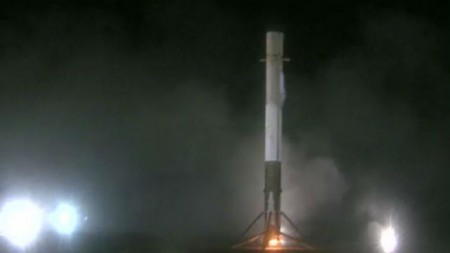December 22, 2015 – We are indeed entering a new phase in accessing outer space. Yesterday SpaceX not only successfully returned its Falcon 9 launch system to flight status, but also after putting a satellite into orbit, returned the rocket to Cape Canaveral with a controlled soft landing. This is the second time in a month that a commercial space company has demonstrated the ability to launch and return a rocket so that it can be refitted and reused.
The Falcon 9 booster rocket stands 15-storeys tall. That’s taller than where my apartment lies in our building’s top floor from where I am writing this blog today. Imagine landing such a structure without it tipping over, the fate of previous landing attempts by SpaceX on a barge off the Florida coast. The barge’s instability as a floating platform partially contributed to these past landing failures.
The triumph of this launch follows a previous Falcon 9 failure that occurred in June of this year. That rocket exploded during assent with the subsequent investigation discovering a faulty internal metal brace that did not meet manufacturer specification. SpaceX subsequently revisited all of its production processes to correct the failure. The result, the reborn Falcon 9 performed flawlessly both during its two minute ascent and the subsequent return to the launch pad 10 minutes after liftoff.
For Elon Musk who has made it his mission statement to make space more accessible by bringing launch costs down, reusability of rocket boosters is essential. Musk told reporters, “It’s a revolutionary moment…No one has ever brought a booster, an orbital-class booster, back intact.”
Last month when Jeff Bezos’ company launched its New Shepard booster to a sub-orbital height of 100 kilometers (62 miles) a twitter war broke out between Bezos’ Blue Origin supporters and SpaceX boosters. At the time Musk pointed out that the New Shepard was not competition for Falcon 9 because it was not capable of reaching the velocity or altitude necessary to put a satellite or human-occupied capsule into near-Earth orbit. The Falcon 9, however, was. So yesterday’s demonstration put Musk’s money where his mouth is.
The launch at Cape Canaveral was a commercial mission to place eleven telecommunications satellites built by OrbComm into orbit. All eleven were successfully deployed. It was also a return to launch status for Falcon 9. But those accomplishments paled in comparison to when the rocket returned to Earth landing at a designated concrete pad approximately 10 kilometers (6 miles) from the launch site.
For SpaceX 2016 is going to be a busy year with a series of commercial resupply missions to the International Space Station (ISS), a number of contracted commercial launches, and the planned first launch of the Falcon Heavy which will be the most powerful booster rocket available when deployed.
The first repeat opportunity for Falcon 9 will come in January with the launch of the SES 9 communications satellite from Cape Canaveral. It will be interesting to see if a second January launch of a Falcon 9 from Vandenberg Air Force Base in California attempts a repeat performance of a controlled landing at a different location. February will see a resupply mission to ISS. Other 2016 missions include at least three more ISS resupply missions as well as launches of U.S., French, Japanese, and Israeli-built communication satellites. It is doubtful that any of these missions will use refurbished Falcon 9 launchers. The company, however, intends to refly these rockets. It just needs to develop a refitting process for this now that the first one has successfully performed as planned.
Refitting and reusing rockets has already been demonstrated by NASA with the Space Shuttle. The main engines were reusable for 55 flights. The solid rocket boosters (SRBs) were recovered, reassembled and tested. Everything in theory was reused.
Back in 2014 at a space conference when asked about first stage Falcon 9 reusability, Stella Guillen, SpaceX director of business development, remarked that “the engines have a cycle of 40.” What are the cost implications of flying a rocket 40 times before having to replace it? Musk believes reusability will drive launch costs down by a factor of more than 100 when all stages of the rocket can be recovered and refitted.
Musk’s vision for reusability was expressed in an interview with Aviation Week back in February 2014 when he stated, “Where I basically see this netting out is Falcon 9 will do satellites to roughly up to 3.5 tonnes with full reusability of the boost stage, and Falcon Heavy will do satellites up to 7 tonnes with full reusability of all three boost stages.” The downside of reusability is the need to include more fuel on board for the controlled descent which means reduced payload to orbit capacity. SpaceX estimates that amounts to approximately 10% in payload reduction. But a fully reusable Falcon Heavy will make payload limitations less of an issue.








